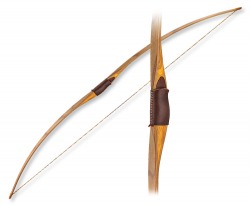The Long Bow
The Basic Longbow

A longbow is a type of bow that is tall (roughly equal to the height of the person who uses it); this will allow its user a fairly long draw, at least to the jaw (the average length of arrowshafts recovered from the 1545 sinking of the Mary Rose is 75 cm/30 in). A longbow is not significantly recurved. Its limbs are relatively narrow so that they are circular or D-shaped in cross section. Flatbows can be just as long; the difference is that, in cross-section, a flatbow has limbs that are approximately rectangular.
Organizations which run archery competitions have set out formal definitions for the various classes; many definitions of the longbow would exclude some medieval examples, materials, and techniques of use.[1][2] According to the British Longbow Society, the English longbow is made so that its thickness is at least ⅝ (62.5%) of its width, as in Victorian longbows, and is widest at the handle. This differs from the Medieval longbow, which had a thickness between 33% and 75% of the width. Also, the Victorian longbow does not bend throughout the entire length, as does the medieval longbow. Longbows have been used for hunting and warfare, by many cultures around the world, a famous example being the English longbow, during the Middle Ages.
Organizations which run archery competitions have set out formal definitions for the various classes; many definitions of the longbow would exclude some medieval examples, materials, and techniques of use.[1][2] According to the British Longbow Society, the English longbow is made so that its thickness is at least ⅝ (62.5%) of its width, as in Victorian longbows, and is widest at the handle. This differs from the Medieval longbow, which had a thickness between 33% and 75% of the width. Also, the Victorian longbow does not bend throughout the entire length, as does the medieval longbow. Longbows have been used for hunting and warfare, by many cultures around the world, a famous example being the English longbow, during the Middle Ages.
The Crossbow
The Basic Crossbow

A crossbow is a weapon consisting of a bow mounted on a stock that shoots projectiles, often called bolts or quarrels. The medieval crossbow was called by many names, most of which derived from the word ballista, a torsion engine resembling a crossbow in appearance.
Historically, crossbows played a significant role in the warfare of East Asia, Europe, and the Mediterranean. Today, they are used primarily for target shooting and hunting.
Historically, crossbows played a significant role in the warfare of East Asia, Europe, and the Mediterranean. Today, they are used primarily for target shooting and hunting.
